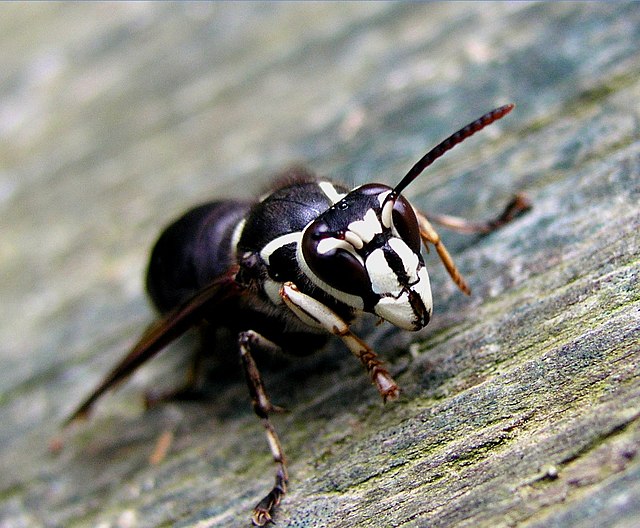All About Bald-faced Hornets
Bald-faced hornets, often mistaken for true hornets, are actually large wasps that are known for their aggressive nature and painful stings. Controlling or managing these pests is crucial, especially when they build their large, aerial nests near human activity. Their stings can be dangerous, particularly for individuals with allergies to insect venom.
What are Bald-faced Hornets?
Bald-faced hornets (Dolichovespula maculata) are a species of wasps commonly referred to as hornets due to their large size and aggressive behavior. Despite their name, they are more closely related to yellowjackets than to true hornets. They are known for their distinctive black and white coloration, particularly the white pattern on their face.
Bald-faced hornets are social insects that live in large colonies. Their nests, which are enclosed in a papery substance made from chewed wood fibers, can house hundreds of individuals. Unlike other stinging insects, bald-faced hornets do not reuse their nests; instead, new queens establish new colonies each year.
How to Identify Bald-faced Hornets
Appearance:
- Color: Black with a distinctive white pattern on the face.
- Size:
- Workers: 1/2 to 5/8 inches (12-15mm) long.
- Queens: Up to 3/4 inches (18-20mm) long.
- Body Shape: Long and wasp-like with a smooth, hairless body.
- Distinguishing Features:
- Two slanted white lines on the midsection.
- White markings on the abdomen.
Similar Pests:
Bald-faced hornets can be confused with other wasps, especially yellowjackets, due to their similar size and nesting habits. However, their black and white coloring and enclosed nests distinguish them from yellowjackets and other wasps, which are typically yellow and black and have open nests.
Activity and Seasonality
Active Seasons: Bald-faced hornets are most active during the late summer when their populations are at their peak.
Lifecycle: In the spring, fertilized queens emerge from hibernation and begin building nests. The queen lays eggs in the nest, and the first generation of workers takes over the duties of expanding the nest, foraging for food, and caring for the larvae. By late summer, the colony can grow to include 100-400 members. As the season progresses, new queens and males are produced, and the old colony dies off after the first frost. The new queens hibernate through the winter, starting the cycle anew the following spring.
Where to Find Bald-faced Hornets in or Around Your House
Common Habitats: Bald-faced hornets build their nests at least three feet off the ground in trees, shrubs, and on the sides of buildings. Their nests can also be found under eaves, on utility poles, and in other protected locations.
Specific Hiding Spots: These hornets often choose areas that are somewhat protected from the elements, such as under the overhangs of roofs, in dense shrubs, or high in trees. Nests can be as large as 24 inches in length and 14 inches in diameter.
How to Get Rid of Bald-faced Hornets
Immediate Action:
If you find a bald-faced hornet nest on your property, do not attempt to remove it yourself. These hornets are highly aggressive and can sting repeatedly.
Professional Treatments:
Contacting a licensed pest control professional is the safest and most effective way to remove a bald-faced hornet nest. Professionals will typically remove nests at night when most of the hornets are inside and less active.
DIY Methods:
DIY pest control is not recommended for bald-faced hornets due to the risk of multiple stings. If you must take action yourself, use a wasp and hornet spray designed for aerial nests, applying it directly into the nest opening at night. Ensure you wear protective clothing, including long sleeves, gloves, and goggles.
How to Prevent Bald-faced Hornets
Seal Entry Points:
- Inspect your home for cracks and small openings where hornets might enter.
- Use caulk or other sealants to close off these potential entry points.
Manage Outdoor Food Sources:
- Keep food covered when dining outdoors to avoid attracting hornets.
- Clean up food spills and dispose of waste promptly.
Avoid Strong Fragrances:
- Choose unscented personal care products when spending time outdoors.
- Refrain from wearing strong perfumes or lotions that might attract hornets.
Protect Your Feet:
- Wear closed-toe shoes when walking in areas where hornets are active.
Professional Assistance:
- Consult a Pest Control Professional: If you notice a nest or suspect an infestation, contact a licensed pest control service.
Conclusion
Bald-faced hornets are aggressive and dangerous pests that require careful management. Their large nests and painful stings make them a serious threat, especially in late summer when their colonies are most active.
If you’re dealing with a bald-faced hornet infestation, contact Pest Control Consultants today for a free consultation and effective treatment plan. Don’t risk handling these aggressive pests on your own—let our professionals take care of it safely and efficiently.
